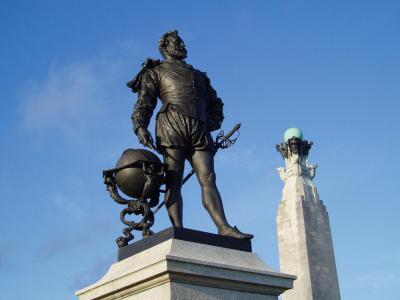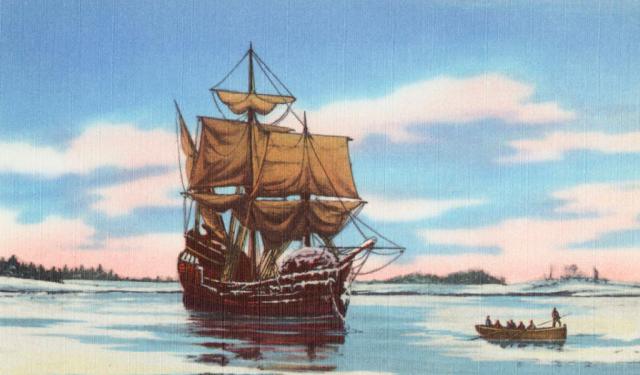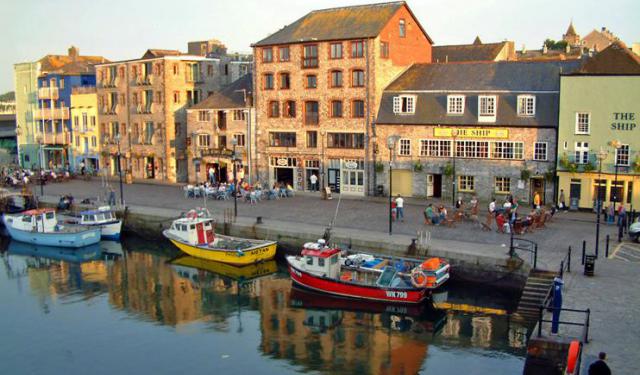Sir Francis Drake's Statue, Plymouth
The bronze statue of Sir Francis Drake in Plymouth stands as a prominent tribute to one of the most renowned seafarers of his era. Overlooking the iconic Hoe, this 10-foot tall monument was sculpted by Joseph Edgar Boehm and unveiled on February 14, 1884, in the presence of Lady Fuller Drake, a distant relative of the celebrated explorer.
Captain Francis Drake holds the distinction of being the first Englishman to successfully circumnavigate the globe. Commissioned in secret by Queen Elizabeth I in 1577, Drake embarked on an ambitious voyage aimed at disrupting Spanish interests on the Pacific coast of the Americas. His expedition was marked by daring raids on Spanish ports and his eventual return to England in 1580, laden with valuable spices and treasure. In recognition of his accomplishments, Elizabeth I knighted Drake in 1581, the same year he was appointed Mayor of Plymouth and subsequently served as a member of parliament.
Drake’s legacy is further cemented by his pivotal role in defending England during the Spanish Armada’s attempted invasion. According to popular lore, Drake was engaged in a game of bowls on Plymouth Hoe on July 20, 1588, when news of the Armada’s approach arrived. Legend has it that he nonchalantly continued his game, confident in the knowledge that the English fleet could not set sail immediately due to prevailing wind and tide conditions. When the time came, Drake led the fleet to victory, adding to his storied reputation.
In 1979, marking the 400th anniversary of Drake’s circumnavigation, the Sir Francis Drake Commission of California gifted Plymouth with a commemorative plaque, recognizing his landing in Marin County, California, in June 1579. This plaque has since been integrated into the base of the statue.
Captain Francis Drake holds the distinction of being the first Englishman to successfully circumnavigate the globe. Commissioned in secret by Queen Elizabeth I in 1577, Drake embarked on an ambitious voyage aimed at disrupting Spanish interests on the Pacific coast of the Americas. His expedition was marked by daring raids on Spanish ports and his eventual return to England in 1580, laden with valuable spices and treasure. In recognition of his accomplishments, Elizabeth I knighted Drake in 1581, the same year he was appointed Mayor of Plymouth and subsequently served as a member of parliament.
Drake’s legacy is further cemented by his pivotal role in defending England during the Spanish Armada’s attempted invasion. According to popular lore, Drake was engaged in a game of bowls on Plymouth Hoe on July 20, 1588, when news of the Armada’s approach arrived. Legend has it that he nonchalantly continued his game, confident in the knowledge that the English fleet could not set sail immediately due to prevailing wind and tide conditions. When the time came, Drake led the fleet to victory, adding to his storied reputation.
In 1979, marking the 400th anniversary of Drake’s circumnavigation, the Sir Francis Drake Commission of California gifted Plymouth with a commemorative plaque, recognizing his landing in Marin County, California, in June 1579. This plaque has since been integrated into the base of the statue.
Want to visit this sight? Check out these Self-Guided Walking Tours in Plymouth. Alternatively, you can download the mobile app "GPSmyCity: Walks in 1K+ Cities" from Apple App Store or Google Play Store. The app turns your mobile device to a personal tour guide and it works offline, so no data plan is needed when traveling abroad.
Sir Francis Drake's Statue on Map
Sight Name: Sir Francis Drake's Statue
Sight Location: Plymouth, England (See walking tours in Plymouth)
Sight Type: Attraction/Landmark
Guide(s) Containing This Sight:
Sight Location: Plymouth, England (See walking tours in Plymouth)
Sight Type: Attraction/Landmark
Guide(s) Containing This Sight:
Walking Tours in Plymouth, England
Create Your Own Walk in Plymouth
Creating your own self-guided walk in Plymouth is easy and fun. Choose the city attractions that you want to see and a walk route map will be created just for you. You can even set your hotel as the start point of the walk.
Plymouth Hoe Walking Tour
Plymouth Hoe, referred to locally as the Hoe, is a large south-facing open public space in Plymouth with commanding views of Plymouth Sound, Drake's Island, and further afield into Cornwall. The name derives from the Anglo-Saxon word hoh, which means a sloping ridge shaped like an inverted foot and heel.
This part of town has always been a meeting place, where people would come regularly... view more
Tour Duration: 1 Hour(s)
Travel Distance: 0.7 Km or 0.4 Miles
This part of town has always been a meeting place, where people would come regularly... view more
Tour Duration: 1 Hour(s)
Travel Distance: 0.7 Km or 0.4 Miles
Pilgrim Fathers Trail
Back in the early 17th century, a group of English Puritans – nowadays reverently referred to as the Pilgrim Fathers – fled religious persecution in their homeland and established a colony in North America that later became known as Plymouth, Massachusetts. The Pilgrims embarked on their perilous journey across the Atlantic from Plymouth, England in 1620 aboard a ship called the Mayflower,... view more
Tour Duration: 1 Hour(s)
Travel Distance: 0.5 Km or 0.3 Miles
Tour Duration: 1 Hour(s)
Travel Distance: 0.5 Km or 0.3 Miles
Plymouth Introduction Walking Tour
Plymouth's early history began in the Bronze Age when the first settlement emerged at Mount Batten. It is mentioned in Ptolemy's Geographia as a maritime outpost exporting bronze mirrors.
The settlement was a major port in the southwest of England in Roman times. It was surpassed as a port in the ninth century by the nearby wealthier village of Sutton, later called Plymouth.
... view more
Tour Duration: 1 Hour(s)
Travel Distance: 1.9 Km or 1.2 Miles
The settlement was a major port in the southwest of England in Roman times. It was surpassed as a port in the ninth century by the nearby wealthier village of Sutton, later called Plymouth.
... view more
Tour Duration: 1 Hour(s)
Travel Distance: 1.9 Km or 1.2 Miles






